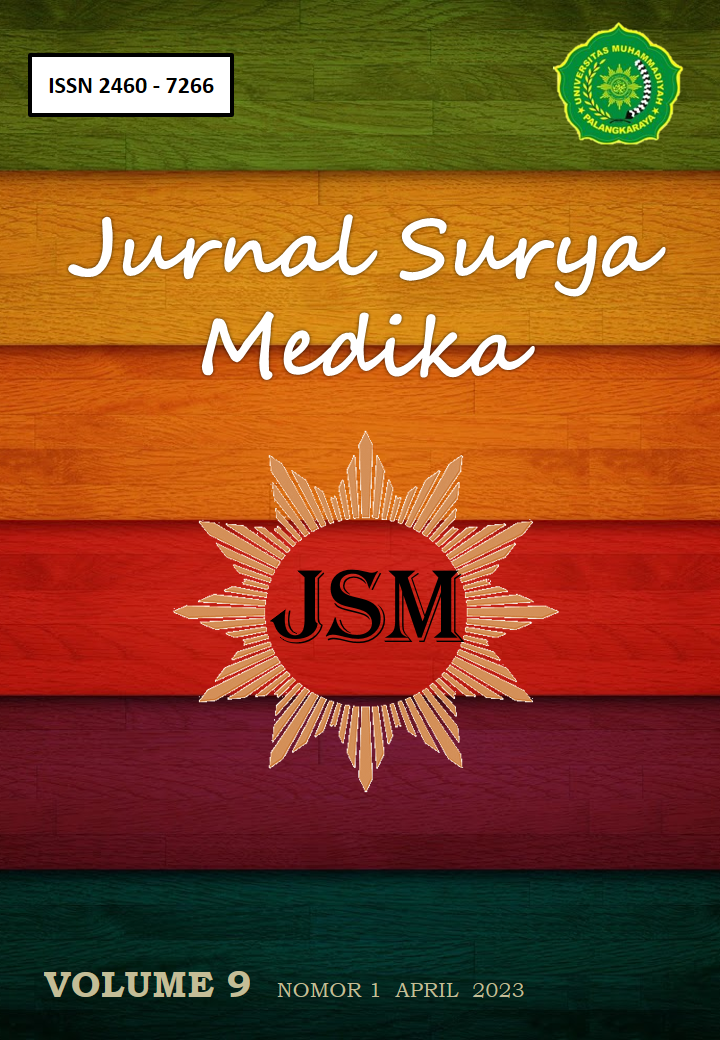Hubungan Pengetahuan Ibu Tentang 1000 Hari Pertama Kehidupan dengan Kejadian Stunting pada Balita di Puskesmas Kereng Bangkirai Kota Palangka Raya The Relationship of Mother's Knowledge About the First 1000 Days of Life With Stunting Events in Toddlers at the Community Health Center Kereng Bangkirai Palangka Raya City
Main Article Content
Abstract
The first thousand days of life are from the first day of pregnancy until the child is two years old which can determine the future of humans. This phase is called the golden period because at this time there is a very rapid brain growth. One of the nutritional problems that often occurs in The first thousand days of life is stunting. The purpose of this study was to determine the relationship between mother's knowledge and the incidence of stunting in toddlers in the working area of Kereng Bangkirai Health Center, Palangkara Raya City in 2022. The design of this study used a descriptive analytic method with a cross sectional approach. The sample in this study were all mothers who have toddlers totaling 60 respondents with purposive sampling technique. The results showed that respondents who had good knowledge of 34 respondents were the majority of normal stunting events, namely 31 respondents (91.2%) while 26 respondents who had less knowledge were the majority of stunting, namely 15 toddlers (57.7%) and the results of the chi-square statistical test analysis obtained Asymp value. Sig = 0.000 < 0.05, it can be concluded that there is a significant relationship between Mother's Knowledge of the First 1000 Days of Life and Stunting Incidence Therefore, for health workers to further improve health promotion efforts for pregnant women and those who have toddlers and can provide counseling about the first thousand days of life with stunting.
Downloads
Article Details

This work is licensed under a Creative Commons Attribution-ShareAlike 4.0 International License.
All rights reserved. This publication may be reproduced, stored in a retrieval system, or transmitted in any form or by any means, electronic, mechanical, photocopying, recording.
References
Agustina, A. 2015. Faktor-faktor Risiko Kejadian Stunted pada Balita (24-59 bulan) di Wilayah Kerja Puskesmas Sosial Palembang Tahun 2014. Skripsi. Fakultas Kesehatan Masyarakat Universitas Sriwijaya.
Kemenkes RI. 2014. Peraturan Menteri Kesehatan Republik Indonesia Nomor 41 Tahun 2014 Tentang Pedoman Gizi Seimbang. (Kemenkes R).
Kemenkes RI. 2018. Balita Pendek (Stunting) di Indonesia (Buletin Je). Pusdatin Kementerian Kesehatan RI.
Kemenko. 2018. Strategi Nasional Percepatan Pencegahan Anak Kerdil (Stunting) Periode 2018-2024.
Notoatmodjo, S. 2013. Pendidikan dan Perilaku Kesehatan. PT. Rineka Cipta.
Notoatmodjo. S. 2012. Metode Penelitian Kesehatan. Rineka Cipta.
UNICEF. 2018. Levels and trends in child malnutrition: key findings of the 2018 Edition of the Joint Child Malnutrition Estimates.
WHO. 2017. Childhood Stunting: Challenges and opportunities, Report of Promotiong Healthy Growth and Preventing Chilhood Stunting Colloguim. rowth and.Adelina, M. (2018). Hubungan Pengetahuan Gizi dan 1000 HPK Ibu Serta Pola Asuh Dengan Status Gizi Balita (BB/U).
